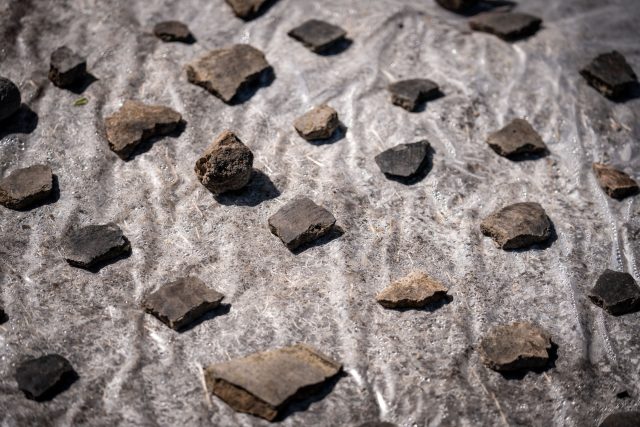During the rescue excavations at Erzurum’s Değirmenler Mound, the initial findings revealed settlements dating back approximately 6,000 years.
The excavation project, named the “Değirmenler Mound Excavation,” was launched on July 1 with the permission and support of the General Directorate of Cultural Heritage and Museums, under the leadership of the Erzurum Museum Directorate. The mound is located in the Değirmenler neighborhood of Yakutiye district.
During the two-month excavation in the area, settlement layers, human and animal bones, and ceramics were among the findings, which are being evaluated according to their historical context.
There are plans to delve deeper into the site to uncover more about its past. The excavations aim to transform the area into an archaeological park.
Professor Mehmet Işıklı, the scientific adviser of the project and head of the Protohistory and Near Eastern Archaeology Department at Atatürk University, told Anadolu Agency (AA) that a different period began in Eastern Anatolia following the Karaz culture.
Işıklı explained that the first state and writing tradition in Eastern Anatolia began with Urartian civilization, “This was about 3,000 years ago, but we are still trying to understand what happened during the 2,000-year gap in between – who lived there, how they lived and the details of that period. We archaeologists refer to this time as the Late Bronze Age and Early Iron Age, spanning over a thousand years. The rescue excavation at Değirmenler Mound is providing valuable data about this period.”
Işıklı also mentioned that around 4,000 years ago, a strong agricultural and pastoral society emerged in the region. He continued: “There were powerful lords in this area at that time. We are currently working to identify the villages of these lords through excavations. We know that there was a strong kingdom centered in Erzurum, which was powerful enough to challenge the Urartian Kingdom, with its fortresses, military strength and rich animal resources. We are currently excavating the villages of these kingdoms.”
Highlighting Erzurum’s rich archaeological potential, Işıklı stated, “Therefore, this excavation is very important and reflects a significant potential. The excavations in this region will beautifully illustrate the cultural texture and deep history of the area. We are essentially making a journey into Erzurum’s deep history, which is very exciting. Each artifact and every stroke of the trowel brings us immense excitement.”
Archaeologist associate professor Gülşah Altunkaynak, who is leading the excavation at Erzurum Museum, noted that regional archaeology has been primarily focused on rescue excavations for many years. She emphasized that valuable results have been obtained from their findings, saying, “Our goal here is to reach the earliest settlement as soon as possible. We aim to leave a step at each layer using the step trench method to reveal different periods and structural phases.”
Altunkaynak elaborated on the ongoing work at the mound: “So far, we have uncovered a medieval cemetery in about 1.5 meters (almost 5 feet) of fill, followed by the Iron Age layer. We have started to remove this layer along with various structural phases, encountering more architectural fill than expected. While such sites usually yield more ceramics or small finds, here the architectural finds are predominant. After completing this architectural layer, we will proceed to the Karaz phase. Karaz is the most well-known Early Bronze Age settlement period in our region. Thus, we might be dealing with a much thicker fill.”
She added that they have identified the Karaz culture in their work, noting that “At Değirmenler, the layers appear with fills close to 1.5 meters. If we find something significant with such fills, we will have the chance to add new data to what we know. We may even plan to go back to the Chalcolithic period. For example, while excavating Alaybeyi Mound as part of the TANAP project, we managed to reach as far back as 4,700 B.C.”
Regarding the findings, Altunkaynak stated: “Değirmenler Mound might provide broader Karaz fills that yield data not previously seen. Our hope is that we might discover an even earlier settlement than Alaybeyi and thereby identify the earliest settlement in the region. It has been suggested that there were no early settlements in this mountainous area, especially during the Neolithic period, which we still don’t fully understand. Our work aims to show that there were indeed settlements in very early periods. Currently, our findings extend to 5,500 – 6,000 years ago, and we can see the Karaz period, but we need to dig deeper to uncover anything earlier.”





